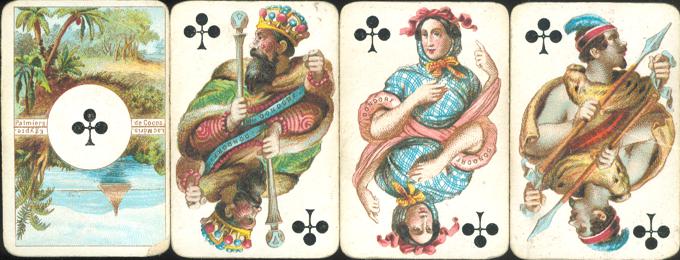 |
DONDORF vs ARMANINO |
|
 |
DONDORF vs ARMANINO |
|
The Dondorf Nr. 27 deck is sometimes referred to as the "four continents patience cards". That goes for the courts, but especially for the aces. The Spades refer to Asia and the aces show the Chinese Great Wall and Indian palm trees; the Hearts stand for Europe and the aces show an Italian forest and a German castle; the Clubs represent Africa and the aces show the Egyptian sea and Coconut palm trees, while the Diamond suit is dedicated to America and these aces show Niagara Falls and the (South) American plains.


This element is not completely taken over by the Armanino
Brothers. The ace of Spades shows palm trees from Ceylon (Sri Lanka) on one
side, but together with the Niagara Falls on the ace of Diamonds and the Sahara
dessert on the ace of Hearts, these are the only international scenes. All other
scenes are Italian. The layout of the aces is practically the same as Dondorf,
only scenes and text are different. Dondorf uses French for their captions
on the aces, Armanino's captions are in Italian.
The courts in the Spades suit illustrate very well how easy it is to mix them up
in a glance. The attributes that they hold are similar and the way their
faces are directed too. Only the costumes and their colors are different, but
who remembers those exactly. Fortunately there are the names to keep them apart.


Just like the general layout and design of the deck, the design of the Armanino courts was definitely "inspired" by those of Dondorf too. The ribbon element as a banner for the makers name is never exactly the same, but sometimes very close. Dondorf consequently mentions their name twice on each ribbon. Armanino mostly mentions the company name once.


The native origin of the courts in regards to their continent
is better illustrated in the Armanino deck: the skin color and features of Asian
and African people are better represented than in the Dondorf deck. One can
wonder if the white lady in the Dondorf clubs suit is there to represent the
European settlers on the African continent, but somehow she looks like a lost
stranger in that suit. In the Diamonds suits the Armanino courts are a bit more
convincing in that respect too.


There is just one thing that these decks have in common: the quality of the chromolithographic printing!
The Dondorf Patience Nr. 27 was first published in 1868 as "Cartes pour Dames". The Armanino deck is from a later date. So we can only guess why such a similar deck was published. Maybe Adolfo Armanino had seen the Dondorf deck and was challenged as an artist and printer to equal the quality of design and printing. But it was also not uncommon for manufacturers in those days to "borrow" popular designs from other manufacturers (in order to increase their own sales).